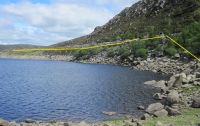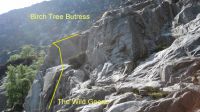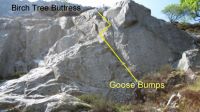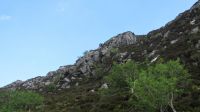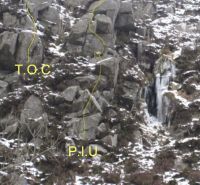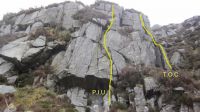Lough Nahanagan
Lough Nahanagan
Nestling in a secluded hollow, overlooked on three sides by steep and craggy slopes, Lough Nahanagan and its environs are worthy of attention. Although quite close to the road, it maintains a sense of remoteness in spite of the ugly ESB compound on the western shore. The sun catching slopes overlooking the compound are studded with interesting slabs and buttresses but many of them are prone to seepage (the fact that they are directly below the reservoir may have a bearing on this) so any prospecting would best be done after a dry spell.
The south and south-eastern slopes have a fair amount of rock. In addition to all of that, there is, tucked away on the shoreline at the southernmost corner of the lough, two contrasting crags of interest to climbers, one a rather smooth slab and the other composed of steep rough granite of good quality.
Approach
Approaching the Wicklow Gap from Laragh turn off just before reaching the crest of the Gap and drive down the access road towards the ESB power station, parking at the junction (there used to be a rustic picnic table and benches here in bygone years). Take the surfaced road to the left, (pedestrian access at the gate) and follow it to where it ends. Go up around the top of the fence and drop back down to find a narrow deer path running parallel to the shore of the lough, between the rocks below and the boulders above. Occasional small cairns. When the path fades take to the boulders and follow a line along the highest ones until, shortly after reaching the trees, dropping down to the shore of the lough. A little over 30 minutes from the car. Alternatively, traverse around above the power station and above the western shore to reach the same point (rough going and nearly always very wet underfoot).
Pine Tree Slab
A slab on, and at right-angles to, the shoreline on the southernmost corner of Lough Nahanagan. There is a solitary pine tree just above the toe of the slab. The gentle angle and the quality of the smooth, compact granite makes this a good place to hone your slab climbing technique, and an ideal spot for a bit of soloing. But the climbing is only part of the picture. Out of sight of the power station, sheltered from the wind and open to sunshine in the mornings, with only the soft slap of the wavelets against the toe of the slab and the occasional honking of the small flock of geese living on the lough to impinge upon the senses, there is a nice feeling of remoteness about this pleasant spot.
The slab, which is just over 20m at its highest point, is bounded on the left by a grassy gully, which has a large birch tree at its bottom and a smaller one near the top. The climbs are described from left to right. Small and medium friends and hexes, as well as small wires, are useful. Descent is down along the crest of the slab to where a short fault line slants back right (looking out).
1. Chanter Diff
Start near the bottom left of the slab, 3m right of a birch tree, on a flat boulder, at the foot of a clean toe of rock. Step up and right to reach good holds. Move back slightly left and go straight up, continuing on good holds to belay in a small rocky bay, just below the top.
E. Hackett, G. Moss 11/9/1993.
2. Grace Notes V. Diff
Start 3m right of Chanter, below a vague fault slanting up left. Follow the line of holds to join the previous route just below the belay point.
E. Hackett, G.Moss 11/9/1993.
3. Piper's Lament S
Start just right of the bottom of a thin, white quartz vein which slopes up to the right. Climb straight to the top, difficulties increasing with height.
G. Moss, E. Hackett 11/9/1993.
4. Slow Air Mod
Start at the centre of the slab, 2m right of the start of Piper's Lament, below the start of the obvious wide fault line sloping up left. Follow the fault to the top, to belay as for Chanter.
E. Hackett, G. Moss 11/9/1993.
5. The Flat Set VS 4c
Start near the right-hand end of the slab and 1m left of the bottom of the short, wide fault line sloping up right.
Climb straight up, crossing the line of The Pipes Are Calling, and step right to reach the foot of some thin, shallow cracks by delicate moves. Finish up these with increasing delicacy. Poorly protected.
G. Moss, E. Hackett 11/9/1993.
6. The Pipes are Calling S
Start near the right-hand end of the slab, at the foot of the short, wide fault line slanting up right (this fault line is used in descent). Scramble up the fault for 2m and make a long step out left to gain an intermittent fault running up diagonally left across the slab. Follow this, with some delicate moves, to finish up as for Chanter.
G. Moss, E. Hackett 11/9/1993.
Birch Tree Buttress
This is the buttress to the left of, and at right-angles to, Pine Tree Slab. There is a birch tree at the bottom right of the buttress. There is a lot of excellent granite here and there may be further possibilities but a lot of the buttress is prone to seepage after wet weather.
1. The Wild Geese VS 4c
Start at the front of the buttress, near the left-hand edge, below and left of a wide bay, at the foot of a crack and shallow right-facing corner, sloping up from left to right. Climb the crack on good holds to a ramp and move up left to the foot of an open-book corner just right of the arête. Climb the corner until it is possible to bridge out left to a foothold on the arête. Airily up the arête to a belay in a niche on the left. Scramble off right (facing in).
G. Moss., E. Hackett. 11/9/1993.
2. Goose Bumps HS 4b
Start below an obvious groove on the right-hand side of the buttress. Climb the groove to a ledge. Make a difficult move back across right to gain a ramp. Follow this easily to a belay just below the top.
G.Moss, E. Hackett 11/9/93
Forked Buttress
There is an interesting rock ridge in the centre of the slope overlooking the eastern shoreline. Forked Buttress is not at all apparent when traversing in along the lough shore from the east, but its potential becomes obvious when viewed from the west.
Decent: Scramble 20m down grassy gully on right of crag to tree and abseil to bottom.
The Old Curiousity VS 4c
1/2. Climb left side of buttress.
3. Scramble up and across to the right hand edge of the headwall.
4. Continue directly to top.
J Reville, G Moss 8/5/2012
Pump it Up * VS 4c
1. Climb right-hand side of buttress, move left up a short wide crack, continue up easier ground. 15m
2. Move up under large square roof, swing left and continue up. Harder alternative is to climb the corner to the right of the roof 8m
3. Move along right wall of buttress then up a chimney. 14m
4. A short scramble to head wall.
5. Step up on a protruding block below centre of face and then follow vertical cracks to top. 15m
C Daly, J. Reville, G. Moss 27/3/2012
